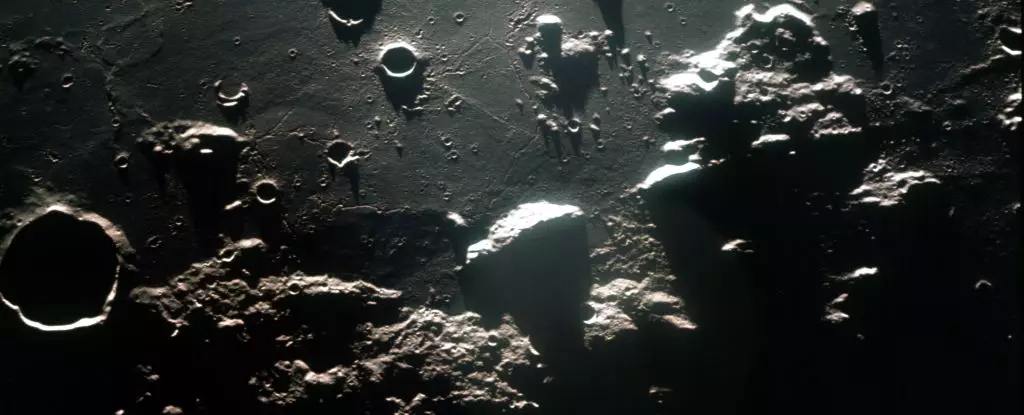

For long, the Moon has been perceived as devoid of significant water resources, almost akin to a barren wasteland. Recent geological analyses, however, have turned this notion on its head. Contrary to the previous belief that water on the lunar surface was limited primarily to the frigid polar regions, new findings indicate that both water and hydroxyl exist in various locations across the Moon’s surface. This discovery not only enriches our understanding of lunar geology but also offers practical avenues for future human missions. The presence of water—even in seemingly inhospitable areas like the equator—opens doors to new possibilities regarding sustained lunar exploration.
The perception of the Moon as a dry celestial body emerges from the stark absence of liquid water on its surface. Yet, ongoing research has highlighted the fact that the Moon contains water, albeit in forms that require re-evaluation of our understanding of its geology. Earlier studies predominantly pointed to polar craters as reservoirs for water—deep, shadowy recesses shielding ice deposits from the Sun’s destructive rays. In contrast, recent research has corroborated the evidence that water and hydroxyl are more widespread, appearing in a variety of geological contexts across the Moon.
Utilizing data from the Moon Mineralogy Mapper aboard India’s Chandrayaan-1 spacecraft, scientists searched for spectral fingerprints of water and hydroxyl within the minerals present on the lunar surface. This advanced spectroscopic analysis revealed that while water and hydroxyl are less prevalent in the expansive lunar mares, they still feature abundantly in smaller rocks across the landscape. This finding highlights an important caveat: the Moon’s geological activity—including crater impacts—plays a crucial role in excavating and redistributing water-rich materials, suggesting that the past and present geological events are intricately linked with lunar hydration.
Interestingly, the longevity of water on the Moon is predictable yet complex. Exposed directly to the harsh environment of outer space, water trapped in the lunar surface is subject to degradation from solar radiation over extended periods. This degradation process usually takes millions of years, resulting in the formation of hydroxyl, a molecule comprising a hydrogen atom bound to an oxygen atom. More intriguingly, hydroxyl formation isn’t solely a byproduct of existing lunar water; it can also arise from chemical reactions initiated by solar wind, whereby solar hydrogen reacts with oxygen on the Moon’s surface.
Roger Clark, a planetary scientist involved in the research, emphasizes the importance of understanding how geological events—ranging from impacts to volcanic activity—interconnect with the presence of water and hydroxyl. Notably, the dynamic nature of cratering reshapes the lunar surface, subsequently relocating water-rich materials closer to the surface layer, effectively creating potential reservoirs for any astronauts who may journey there in the future.
The Moon’s geology presents myriad puzzles, one of which relates to the mineral pyroxene. Recent findings shed light on its water signatures, revealing that the signatures change with varying sunlight angles—an observation that previously perplexed scientists. This observation could imply that water movement on the Moon is not as extensive as once thought.
Moreover, the phenomenon of lunar swirls—enigmatic, twisting patterns scattered across the surface—has captured scientists’ imagination for years. These swirls exhibit a surprising degree of water scarcity, hinting at their formation processes. Could these patterns be remnants of ancient swirls that have since eroded? This could implicate a history of geological events that influenced their evolution, potentially keeping lunar scientists engaged for years as they decode the implications of these patterns on our understanding of the Moon’s surface.
As we look towards a future of lunar exploration, understanding the Moon’s hidden reservoirs of water becomes profoundly significant. The possibility of extracting water from hydroxyl-filled minerals suggests that future astronauts could indeed ‘squeeze water out of a stone,’ offering opportunities for life support and resource utilization during extended missions.
The Moon’s geology is revealing itself not only as a monumental archive of cosmic history but also as a treasure trove for future human endeavors. The renewed focus on lunar hydration represents a pivotal shift in our engagement with Earth’s celestial neighbor, ushering in an era where exploration is both ambitious and resource-driven. As we position ourselves for human exploration beyond Earth’s confines, our understanding of lunar water will undoubtedly play a critical role in shaping our extraterrestrial ambitions.
In the realm of software development, the ability to swiftly and accurately address bugs is…
The realm of quantum computing and communication is not just an abstract dream anymore; it…
In a remarkable leap for the field of material science, a collaborative research initiative has…
Throughout Earth's vast history, our planet has endured five major mass extinction events that reshaped…
Rainfall is a vital element of our planet’s hydrological cycle, yet many aspects of its…
On a night when the universe aligns, a mesmerizing phenomenon awaits: the appearance of the…
This website uses cookies.